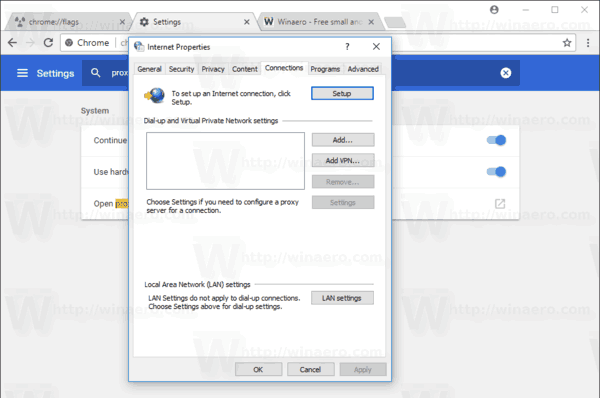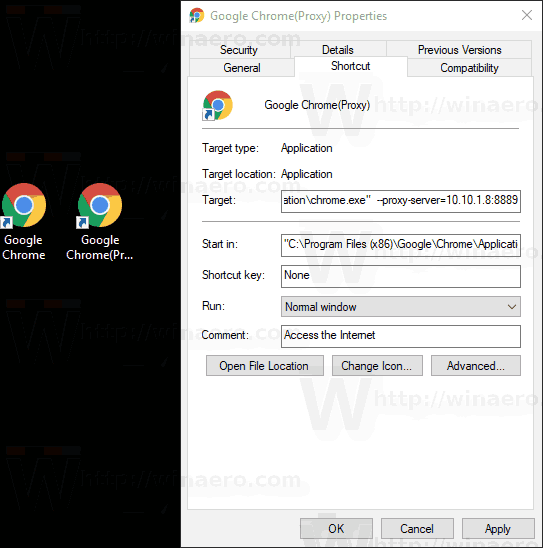If you are a Google Chrome user, you may be aware of how it works with proxies. The browser doesn't include its own proxy settings on Windows. Instead, it follows the system settings, sharing the options with Microsoft Edge, Internet Explorer and the Windows OS itself. Here is how to specify separate proxy settings for Chrome.
Advertisеment
Google Chrome is the most popular web browser which exists for all major platforms like Windows, Android and Linux. It comes with a powerful rendering engine which supports all modern web standards. At the moment of this writing, the most recent version of the browser is Chrome 63 (see its change log).
The proxy implementation in Google Chrome or Chromium is something I never liked. It forces you to specify the proxy in the OS. In Windows, this must be done with the Internet Options in the classic Control Panel. In Linux, this should be done in the Desktop Environment like Gnome or KDE.

Although this design makes the proxy option accessible to all the installed software, a per-app proxy setting is more flexible. If you need to allow only certain apps to use proxy and keep the rest of the apps offline, it is not a good idea to specify proxy server options globally.
Thankfully, you can still configure this in Google Chrome via the command line. You can add a special option via a shortcut, so Chrome will use separate proxy server options which are not related to the OS.
To override System Proxy settings in Google Chrome, do the following.
- Copy the existing Google Chrome shortcut and rename it to Google Chrome (Proxy).
- Right-right the shortcut you created and put the following line after the chrome.exe portion:
--proxy-server=host:port
For example,chrome.exe --proxy-server=10.10.1.8:8889

You are done!
Here are some details about this switch.
The Proxy Command Line Option in Google Chrome
The --proxy-server switch supports HTTP/SOCKS4/SOCKS5 proxy servers. The appropriate scheme can be specified using the following syntax:
[<proxy-scheme>://]<proxy-host>[:<proxy-port>]
The proxy-scheme portion is the protocol of the proxy server, which can be one of the following values:
- http
- socks
- socks4
- socks5
You can specify different proxy servers for different URL types. See the following example:
--proxy-server="https=proxy1:80;http=socks4://proxy2:1080;ftp=proxy3:3128"
The option above specifies three different proxy servers for http, https and FTP.
Other Related Options
--no-proxy-server
This option disables the proxy server. Overrides any environment variables or settings picked via the options dialog.
--proxy-auto-detect
Autodetect proxy configuration. Overrides any environment variables or settings picked via the options dialog.
--proxy-bypass-list="*.google.com;127.0.0.1"
This option tells not to use proxy for the list of addresses delimited by a semicolon. In the example above, the proxy server won't be used for google.com and all its 3rd-level domains along with the 127.0.0.1 address.
--proxy-pac-url=pac-file-url
This tells Chrome to use the PAC file at the specified URL. Useful when you have a PAC file configured by your system administrator.
Support us
Winaero greatly relies on your support. You can help the site keep bringing you interesting and useful content and software by using these options:

How can I tailor that into same function I did on firefox.
On FF I chose manual proxy configs SOCKS HOST is localhost with port 80 (SOCKS V5)
Also in the no proxy for field I entered localhost,127.0.0.1
The above works perfectly on firefox. But I can’t seem to know how can I do it through Chrome.